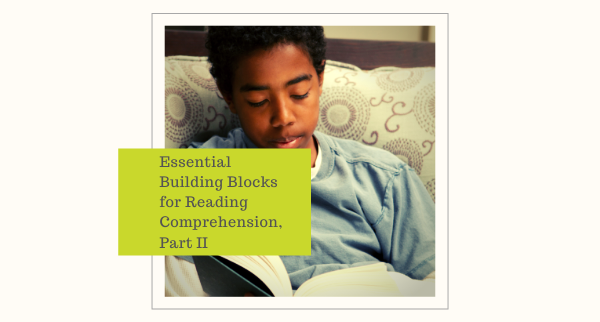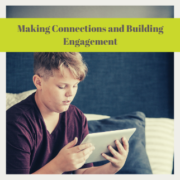Essential Building Blocks for Reading Comprehension, Part II
As mentioned in part one, much of the reason that young learners might struggle with reading comprehension is the fact that the process involves a compilation of other complex skills. Such foundational skills necessary for children to begin to master reading comprehension include: fluency, phonemic awareness, accessing prior knowledge/making connections, vocabulary, syntactical rules/conventions, working memory, and attentiveness.
Vocabulary Strategies
- Instruct children about specific vocabulary terms, but make sure that the new words are connected to something they are currently reading, seeing, hearing, or learning about. It is important to avoid teaching vocabulary “in a vacuum.” Vocabulary words taught at random or with little context or connectivity to prior knowledge is not likely to make it into a child’s lexicon.
- Pre–teach new vocabulary terms by relating them to concepts and terms that your child already knows. Then, when she encounters the word in a text, she will have prior exposure to the word and some sense of understanding.
- Utilize root word instruction and practices. This might include creating root word charts with examples, opposite T-charts, visual word tree trunks with various prefixes and suffixes. Practice making new or nonexistent words using roots as a silly way to grasp root word meanings.
- Use synonyms casually when speaking to your child.
- Create a word web wall and add to the web as you make connections between new words.
- Emphasize context clues while reading aloud; model how to actively engage with new words by making comments like, “I wonder what this might mean in the sentence given the surrounding information…”
Syntax Rules and Conventions
- Ask your child to rearrange the words in the sentence, but maintain the same meaning. For example, given the sentence “You can watch a show after you have finished your homework.” Your child should rephrase by saying something like, “You must finish your homework before you can watch a show.”
- Demonstrate different ways in which sentences can be combined, separated, or punctuated. The key is to show them that, even with variations in sentence structure, the phrases mean the same thing.
- Model the process of summarizing a short excerpt or sentence. Then explain how paraphrasing is slightly different. Practice this process aloud together.
- Exaggerate the purpose of punctuation while reading aloud to emphasize each punctuation mark’s function.
- Provide examples of how punctuation can drastically change the underlying meaning of a sentence. One favorite example is, “Let’s eat, Grandma!” vs. “Let’s eat Grandma!”
- Find fill-in-the-blank reading options, where children are provided with word banks or suggestions on each page, but must use the context of the story to correctly complete each missing word.
Working Memory and Attention Strategies
- Purposefully chunk down larger sections of text while reading aloud. Then ask clarifying questions or practice summarizing the section before moving to the next passage or chunk.
- Ask your child to make predictions while reading to practice recalling and utilizing details that have already been mentioned in the text.
- Plan for engaging questions while reading. Parents should preview the text and think about ways in which to connect the details to other aspects of a child’s life. Ask critical thinking questions as well, such as, “Why do you think the character did that?” “What do you think she meant when she said…?” “How would you have reacted differently if you were in the story?”
- Sketch a visual timeline of events while reading. This doesn’t have to be a detailed, moment-by-moment recollection; you can use bullet points on sticky notes, a small white board, or index cards with events 1-3 on them. Be sure to deliberately emphasize the use of transition words, especially when focusing on chronological summaries.
- Listen to an audio version of the text while following along with the physical book.
- When reading together, once you reach the bottom of a page, ask your child which detail stands out to her the most. If she’s unable to recall a significant detail, encourage rereading.
- Remove all distractions while reading, including background noise, cell phones/screens, etc. You can also find texts with larger print, reduced text per page, and print with extra space between paragraphs to help children visually focus on one aspect of the text at a time.








